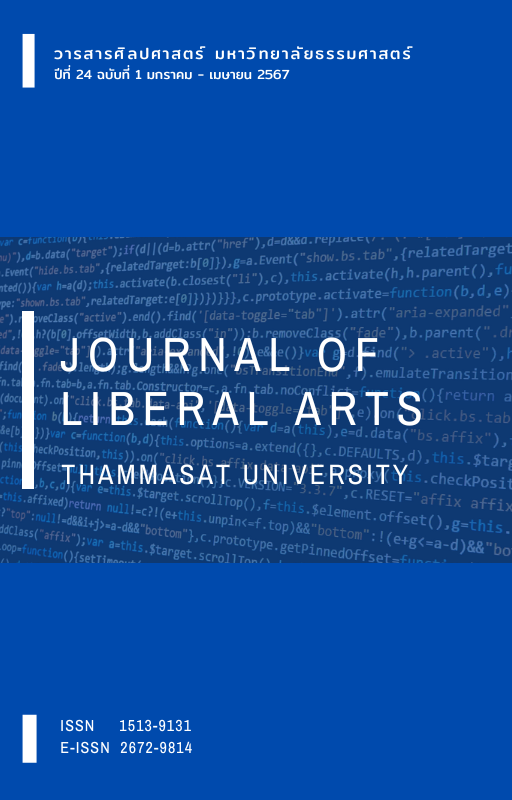Resinicization in the Third or Fourth Generation of Thai-Chinese People: A Case Study of Entrepreneurs of Chinese-style Cafes in Chiang Mai Province
Main Article Content
Abstract
This qualitative research studies Resinicization as a cultural process of commoditization in entrepreneurs who are third or fourth generation Thai-Chinese through examining their motivations for using Chineseness as the café’s identity as well as meanings given to “Chineseness.” Data was collected from 3 case studies, by using documentary research, participant observation, and in-depth interviews. Then it analyzes data with the concept of the Cultural Process of Commoditization. The findings show that the emergence of Chinese-style cafés is not only about consumerism but also a consequence of the historical context of overseas Chinese in Thailand and the rise of China. Chinese symbols used in decoration may not mainly signify overseas Chinese culture, but instead vague Chineseness. Meanings of Chineseness in brand stories are linked with a membership of Thai-Chinese family, without necessarily attaching to the mainstream discourse of nation states.
Downloads
Article Details

This work is licensed under a Creative Commons Attribution-NonCommercial-NoDerivatives 4.0 International License.
References
กิตยุตม์ กิตติธรสกุล. (2557). ยุคสงครามโลกครั้งที่ 2 และยุคแรกเริ่มสงครามเย็นกับบทบาททางเศรษฐกิจของคนจีนในเชียงใหม่. วารสารสังคมลุ่มน้ำโขง, 10(2), 24.
ไกรวิสุทธิ์ รณขัณฑ์ทอสกุล. (2563). อัตลักษณ์ของชาวจีนตรอกเล่าโจ๊ว อำเภอเมือง จังหวัดเชียงใหม่ [วิทยานิพนธ์ปริญญามหาบัณฑิต, มหาวิทยาลัยมหิดล]. ห้องสมุดงานวิจัยสำหรับสาธารณะ. http://164.115.28.46/thaiexen/search_detail/result/10587
ชัยพงษ์ สำเนียง. (2565). เจ้า พ่อค้า ชาวนา นายทุนและเครือข่ายธุรกิจ (พิมพ์ครั้งที่ 2). สยามปริทัศน์.
ฐิติชาญ ศรีดี. (2560). การเปลี่ยนแปลงของอาหารญี่ปุ่นในสังคมไทย: กรณีศึกษาร้านอาหารญี่ปุ่นในอำเภอเมือง จังหวัดเชียงใหม่ [การค้นคว้าอิสระปริญญามหาบัณฑิต, มหาวิทยาลัยเชียงใหม่]. คลังสารสนเทศดิจิทัลมหาวิทยาลัยเชียงใหม่.
ธีรพันธ์ ลีลาวรรณสุข. (28 สิงหาคม 2560). Ba Hao เบื้องหลังการเปลี่ยนตึกแถววินเทจย่าน วงเวียน 22 มาเป็นร้านอาหารและห้องพักหมายเลข 8. The Cloud. https://readthecloud.co/replace-3/
นรุตม์ คุปต์ธนโรจน์. (2558). ย่านไชน่าทาวน์เยาวราช: พื้นที่การนำเสนออัตลักษณ์เชิงซ้อนของวัฒนธรรมความเป็นจีนในสังคมไทยร่วมสมัย [วิทยานิพนธ์ปริญญาดุษฎีบัณฑิต, จุฬาลงกรณ์มหาวิทยาลัย]. Chulalongkorn University Intellectual Repository (CUIR).
นิโลบล วงศ์ภัทรนนท์. (2564). จาก ลอดลายมังกร สู่ เลือดข้นคนจาง: การนำเสนออัตลักษณ์ทางวัฒนธรรมความเป็นชาวไทยเชื้อสายจีนในละครโทรทัศน์ไทย. วารสารวิชาการมนุษยศาสตร์และสังคมศาสตร์ มหาวิทยาลัยบูรพา, 29(2), 76-102.
ปรีดา อัครจันทโชติ. (2561). ความเป็นจีนในละครโทรทัศน์ไทย. วารสารนิเทศศาสตร์, 36(1), 1-20.
ปลายอ้อ ชนะนนท์. (2530). นายทุนพ่อค้ากับการก่อตัวและขยายตัวของระบอบทุนนิยมในภาคเหนือของไทย พ.ศ.2464-2523. สร้างสรรค์.
มุจลินทร์ เพ็ชรรุ่ง. (2553). การศึกษาบทบาทของชาวจีนใน อ.เมือง จ.เชียงใหม่ในสมัยรัตนโกสินทร์ [การศึกษาค้นคว้าอิสระปริญญามหาบัณฑิต, มหาวิทยาลัยศิลปากร]. Silpakorn University Repository : SURE.
ยศ สันตสมบัติ. (2557). มังกรหลากสี : การขยายอิทธิพลเหนือดินแดนและพันธกิจเผยแผ่อารยธรรมในอุษาคเนย์. ศูนย์ศึกษาความหลากหลายทางชีวภาพ และภูมิปัญญาท้องถิ่นเพื่อการพัฒนาอย่างยั่งยืน. มหาวิทยาลัยเชียงใหม่, คณะสังคมศาสตร์.
สิทธิเทพ เอกสิทธิพงษ์. (2566). เป็นจีนเพราะรู้สึก: ประวัติศาสตร์เสื่อผืนหมอนใบที่เพิ่งสร้าง. มติชน.
Althusser, L. (2014). Appendix 2: Ideology and ideological state apparatuses (notes towards an investigation). In L. Althusser (Ed.), & G. M. Goshgarian (Trans.), On the reproduction of capitalism: Ideology and ideological state apparatuses (pp. 232-272). Verso.
Ang, S. (2022). Contesting Chineseness : Nationality, class, gender and new Chinese migrants. Amsterdam University Press.
Appadurai, A. (Ed.). (1986). The social life of things: Commodities in cultural perspective. Cambridge University Press. https://www.bangkokpost.com/life/social-and-lifestyle/1413014/cool-china
Chun, A. (2017). Forget Chineseness : On the geopolitics of cultural identification. SUNY Press.
Concha, P. (2020). Curating pop-up street food markets in London. In E. Falconer (Ed.), Space, taste and affect: Atmosphere that shape the way we eat (pp. 131-141). Routledge. https://doi.org/10.4324/9781315307473
Falconer, E. (2020). Space, taste and affect: An introduction. In E. Falconer (Ed.), Space, taste and affect: Atmosphere that shape the way we eat (pp.1-15). Routledge. https://doi.org/10.4324/9781315307473
Felton, E. (2019). Filtered coffee, the café and the 21st-century city. Routledge.
Han, E. (2022). Re-encountering the familiar other: Contesting ‘re-sinicization’ in Thailand. Singapore Journal of Tropical Geography, 43(3), 270-286. https://doi.org/10.1111/sjtg/12421
Hau, C.-S. (2012). Becoming “Chinese”—but what “Chinese”?—in Southeast Asia. The Asia-Pacific Journal: Japan Focus, 10(26), 1-37.
Hoon, C.-Y., & Chan Y.-K. (Eds.). (2021). Contesting Chineseness: Ethnicity, identity, and nation in China and Southeast Asia. Springer Nature.
Huang, S. (2010). Reproducing Chinese culture in diaspora: Sustainable agriculture and petrified culture in northern Thailand. Lexington Books.
Leeman, J., & Modan, G. (2010). Selling the city: Language, ethnicity and commodified Space. In E. Shohamy, E. Ben-Rafael, & M. Barni (Eds.), Linguistic landscape in the city (pp.182-215). Multilingual Matters.
Sutthavong, A. (2018, February 16). Cool China. Bangkok Post. https://www.bangkokpost.com/life/social-and-lifestyle/1413014/cool-china

